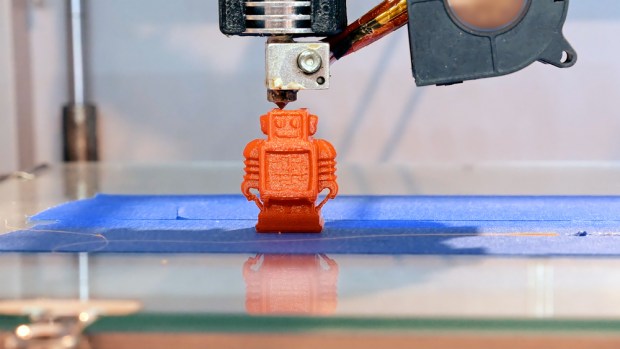Just-In-Time Manufacturing Lowers Entry Barrier For Artisans

Technology like 3-D printing is getting more affordable and accessible by the day, so it seems almost inevitable that it would start to have an impact on manufacturing and production for consumer retail, but Voodoo Manufacturing CEO Max Friefeld says it’s not happening yet, and it likely won’t occur in a big way until the industry settles a bit from the digital shakeup.
Still, for some, 3-D printing is making a huge difference for businesses — specifically, the difference between having a business and not. For others, the ability to outsource 3-D printing to a partner like Voodoo has enabled them to scale and introduce new product lines that weren’t possible when they were running productions entirely from their living room.
Located just outside New York City, Voodoo Manufacturing is one of the largest, high-volume 3-D printing facilities in the world, and Friefeld said it’s putting that volume to work for entrepreneurs with a new Fulfilled by Voodoo offering.
Fulfilled by Voodoo allows entrepreneurs and artisans on marketplaces such as Shopify, Amazon and Etsy to 3-D print their products on demand with “just-in-time” manufacturing — a practice that Friefeld told PYMNTS could have much bigger implications across the industry within the next 10 years.
Beyond that, he envisions how 3-D printing could transform an aspect of the eCommerce stack that has so far gone untouched — namely, production, including the assembly of non-printed components such as wiring and speakers with printed ones.
“Stripe has enabled the eCommerce stack to be simpler in terms of payments,” Friefeld said. “And warehousing is figured out, too — I can set up shop and store my inventory with Amazon without knowing anything about warehousing. This is our opportunity to automate and simplify another part of the eCommerce stack that hasn’t been automated before.”
Moving Production Out of the Living Room
Friefeld said manufacturing is one of the most challenging parts of selling any type of physical good.
Today, a lot of manufactured products are made cheaply in China and are shipped to the U.S., where they’re warehoused, ready to be supplied to customers as soon as they ask for them.
Friefeld said that means anyone wanting to start selling manufactured goods is likely traveling overseas several times (at their own expense) to set up supply chain arrangements. Then, those thin-margin entrepreneurs must make their best guess of how many units they’ll sell and order them — and find a place to keep those units until they do sell.
Alternatively, he said, many artisans are running their own production out of a living room, basement or garage using commercially available 3-D printers. That’s fine for starting out, said Friefeld — and many entrepreneurs find success this way — but if they hope to scale, they’re going to run out of space and hours to keep up with orders.
The demands of production can keep them from innovating new products and product lines, which Friefeld said is the true passion for many of these small business (SMB) owners; 3-D printing is just a means of accomplishing that and bringing their ideas to life.
Outsourcing production removes the capacity constraints and enables those creators to come up with new products and improve their offering, said Friefeld — and they can save time, space and money by only producing what they need, when they need it.
Lean Manufacturing
Traditionally, the cheapest way to produce something was to do it en masse. The theory was that the most efficient and cost-effective way to get products to consumers was to have exactly what they want produced and ready to sell or sent to them the moment they request it.
When customers walk into Costco, said Friefeld, there are plenty of TVs sitting there for them to buy; they don’t have to order one and wait for it to be manufactured and delivered. But the downside of that convenience can be thousands of unsold TVs being recycled or, worse, added to landfills. And manufacturers know this, Friefeld added — they price it into their production costs.
Toyota was the first to implement what is now a common practice: Lean manufacturing. It’s logistically challenging, but, done right, Friefeld said it can save all that waste from overproduction.
When making a car, there are thousands of parts involved, and those are manufactured at different parts of the facility or even offsite. Factories strive to have on hand the parts they need — and only the parts they need — to make the cars they’re scheduled to make.
That’s a localized example of what Friefeld said Voodoo is trying to take all the way to the end consumer. The big challenge, he said, is that in the age of Amazon, everybody wants their stuff in two days or less; they’re used to the old model where goods are sitting on a shelf just waiting for someone to want them.
To run a successful just-in-time manufacturing practice, Friefeld said, companies need a lot of funding. Nike and Converse do it with customized shoes, which shoppers can make to their exact specifications using the brands’ websites. An SMB running out of somebody’s living room could never hope to achieve such a thing. This, said Friefeld, is what Voodoo aims to deliver.
“Our long-term goal is to make manufacturing accessible to anybody,” he said.
Anybody, Anytime Manufacturing
Because manufacturing overseas costs less, many companies take this route. Friefeld said it’s only a matter of time before that shifts. Businesses will start to realize that producing in the U.S. can save them time and money, even if production costs may appear to be higher when viewed in isolation.
The truth is, said Friefeld, shipping from China and warehousing products that may or may not sell is costly and adds significant time to the innovation cycle — whereas just-in-time manufacturing speeds up the innovation process and avoids the costs and uncertainty of storing inventory. Products are created on demand and shipped directly.
“That more than makes up for the difference in labor costs to produce something in the USA,” he said.
